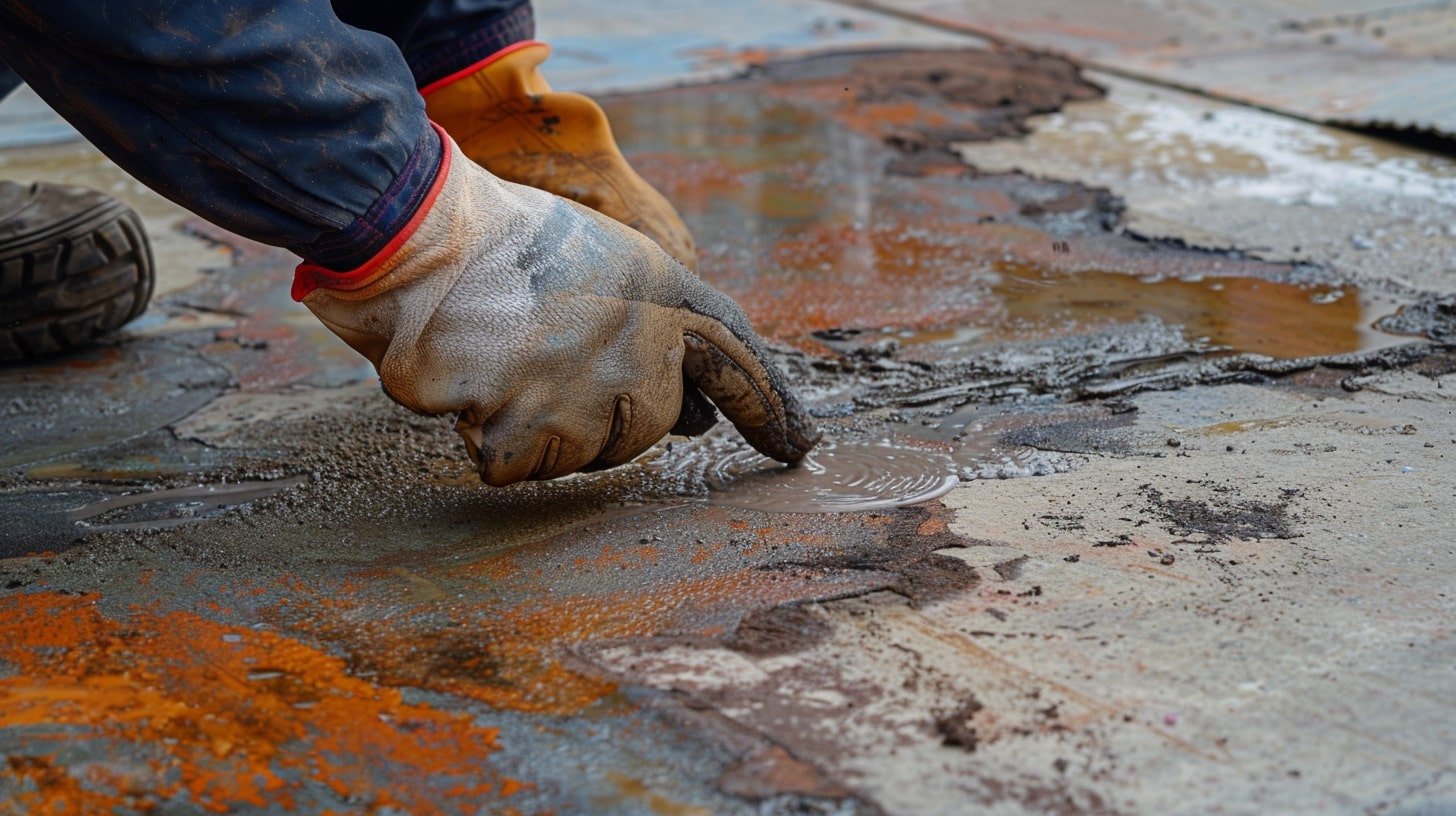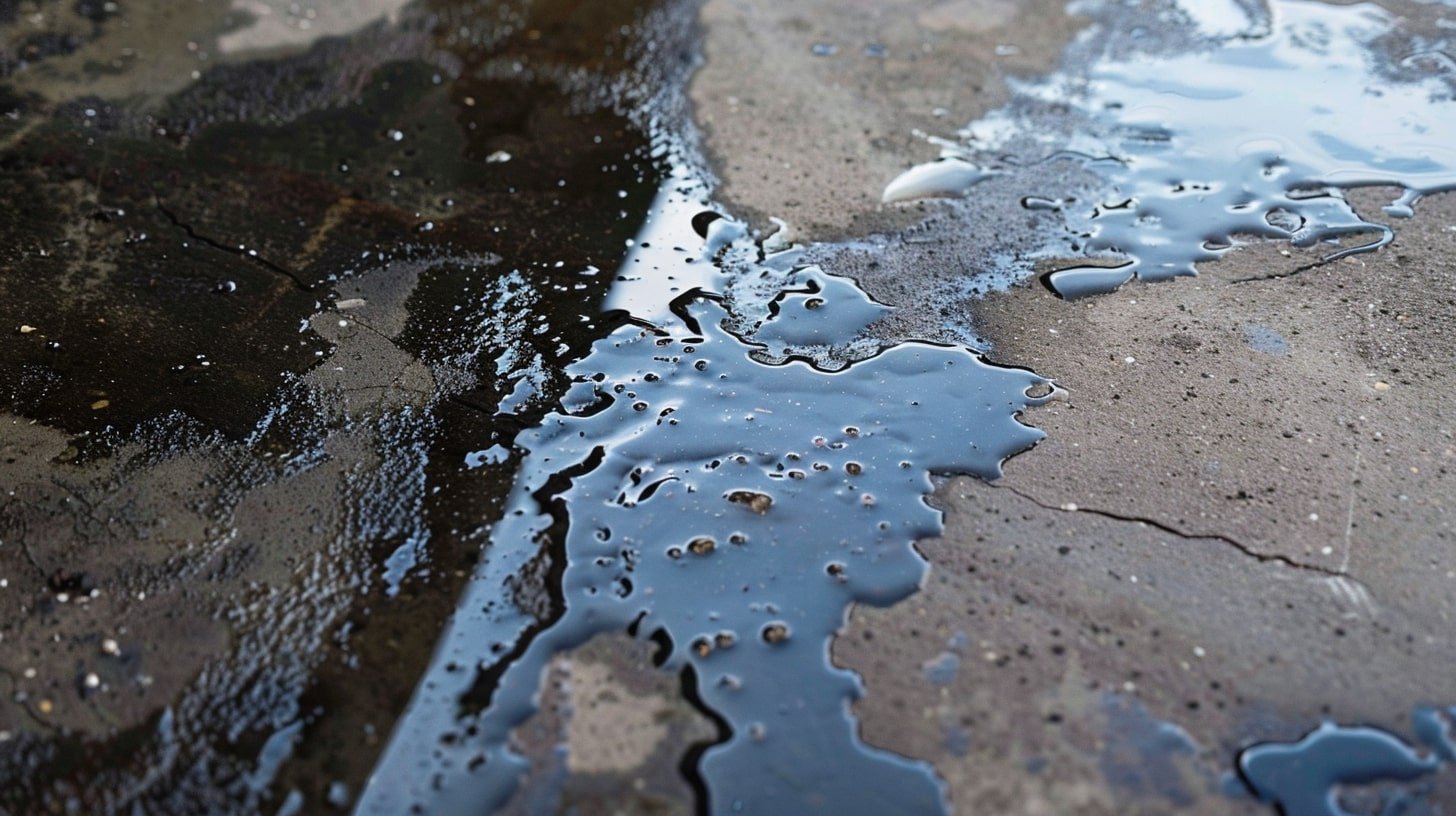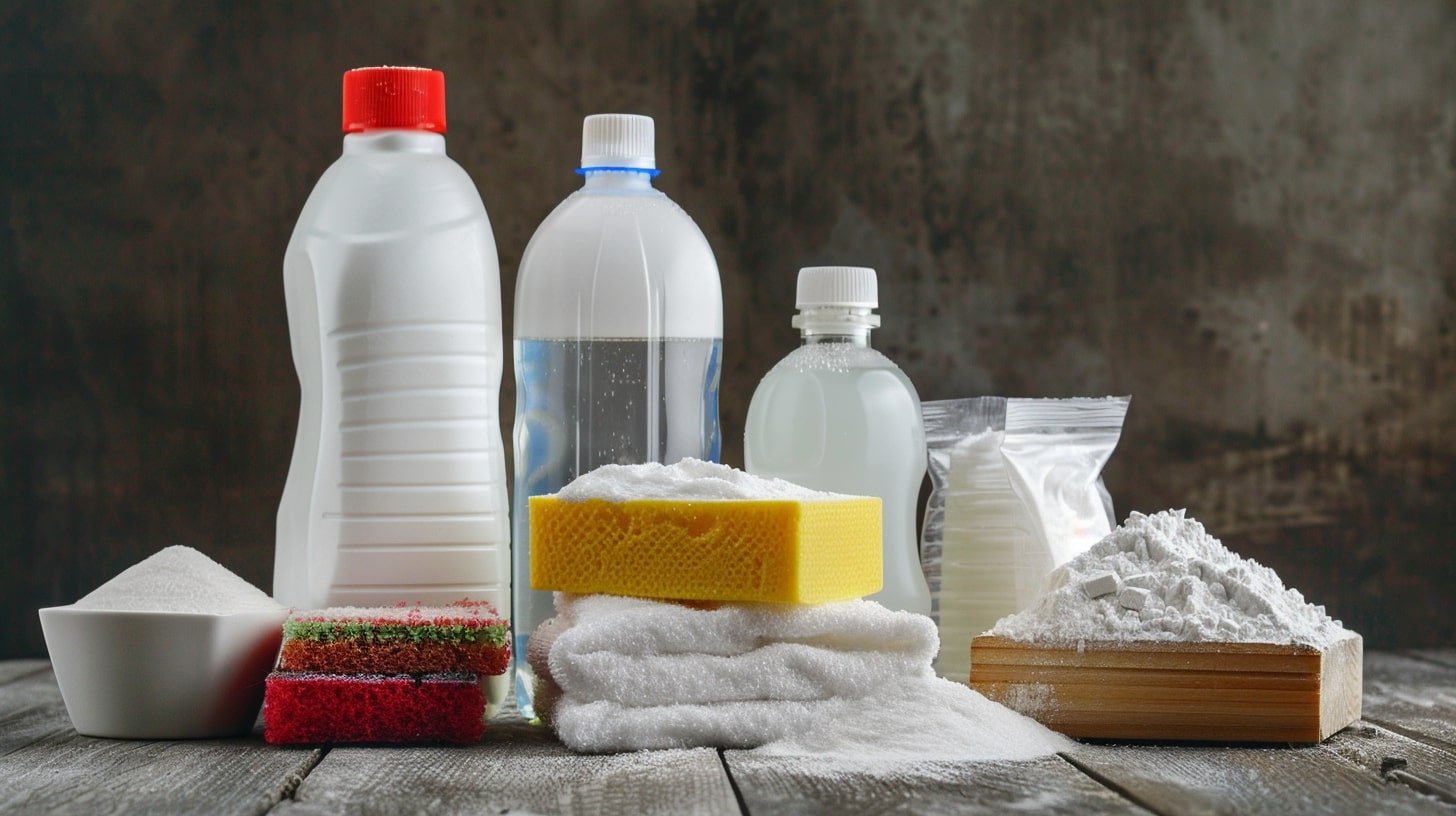Oil stains on concrete are a common issue for homeowners and businesses alike. Whether it’s from vehicle leaks in your driveway or spills in a garage or workshop, oil stains can be unsightly and difficult to remove. The porous nature of concrete allows oil to penetrate deeply, making it tough to clean with just soap and water. Addressing these stains promptly is crucial not only for aesthetic reasons but also to prevent long-term damage.
Table of Contents
Concrete is a durable material, but it’s not impervious to staining. Oil stains can weaken the concrete over time if not properly treated. This can lead to cracks and a generally deteriorated appearance. Knowing the types of oil stains and their impact can help in selecting the right treatment method.
Causes of Oil Stains
Oil stains typically result from motor oil, hydraulic oil, or even cooking oil. In residential areas, vehicle leaks are the primary culprit. Over time, even small drips can create large stains. In industrial settings, heavy machinery and equipment are often the sources of oil spills. Understanding the source and type of oil is the first step in choosing an effective cleaning method.
Types of Oil Stains and Their Impact
There are various types of oil stains, each with different impacts on concrete. Fresh oil stains are easier to clean, while older, set-in stains require more effort and stronger cleaning agents. Oil can also combine with dirt and other contaminants, making the stain even tougher to remove. Prolonged exposure to oil can cause concrete to become brittle, leading to potential structural issues.
Importance of Addressing Oil Stains Promptly
Ignoring oil stains can lead to permanent discolouration and potential weakening of the concrete. Prompt treatment not only preserves the appearance but also extends the lifespan of your concrete surfaces. Regular maintenance and immediate action on new stains are key to maintaining concrete resilience.
Preparing for Oil Stain Removal
Removing oil stains from concrete requires proper preparation to ensure safety and effectiveness. Here’s a step-by-step guide to get you started:
Safety Precautions
Before you begin, it’s essential to prioritize safety. Working with chemicals and cleaning agents can pose health risks. Wear protective gear such as gloves, goggles, and a mask to prevent skin and eye irritation. Ensure the area is well-ventilated, especially if you’re working in an enclosed space like a garage.
Necessary Tools and Materials
Having the right tools and materials on hand will make the cleaning process smoother and more efficient. Here’s a checklist to get you started:
- Gloves and Safety Goggles: To protect your hands and eyes from harsh chemicals.
- Stiff Bristle Brush: For scrubbing the stained area.
- Absorbent Materials: Such as cat litter or sawdust, to soak up excess oil.
- Commercial Oil Stain Remover: Choose a high-quality product suited for concrete.
- DIY Cleaning Solutions: Ingredients like baking soda, dish soap, and vinegar.
- Buckets and Sponges: For mixing and applying cleaning solutions.
- Pressure Washer: Optional, but highly effective for deep cleaning.
Pre-treatment Steps
Before applying any cleaning solution, it’s crucial to prepare the stained area properly:
- Clear the Area: Remove any debris, dirt, or loose materials from the concrete surface.
- Absorb Excess Oil: Use absorbent materials like cat litter or sawdust to soak up any standing oil. Let it sit for a few hours before sweeping it away.
- Test the Cleaning Method: Before applying the cleaner to the entire stain, test it on a small, inconspicuous area to ensure it doesn’t cause any damage or discolouration.
Following these preparation steps ensures that the cleaning process will be more effective and safe.
Best Treatments for Oil Stains
When it comes to removing oil stains from concrete, you have several options. Each method has its pros and cons, so it’s important to choose the one that best suits your needs.
Commercial Cleaners
Commercial oil stain removers are specifically formulated to break down and lift oil from concrete surfaces. They are often the most effective option, especially for stubborn stains. Here are some top-rated commercial products:
- Oil Eater Cleaner/Degreaser: Known for its powerful degreasing properties.
- Chomp Pull It Out Oil/Stain Remover: A poultice formula that draws out deep-set stains.
- ACT Concrete Cleaner: An eco-friendly option that uses microorganisms to digest oil.
DIY Solutions
If you prefer a more natural approach, there are several DIY solutions that can effectively remove oil stains from concrete:
- Baking Soda and Dish Soap: Sprinkle baking soda over the stain, then apply dish soap. Scrub with a stiff brush and rinse with water.
- Vinegar and Baking Soda Mixture: Mix equal parts vinegar and water, apply to the stain, and sprinkle baking soda on top. Scrub and rinse.
- Laundry Detergent: Mix a strong solution of laundry detergent and water, apply to the stain, scrub, and rinse.
Here’s a detailed step-by-step guide for using these DIY solutions:
- Sprinkle the Cleaning Agent: Start by sprinkling baking soda or laundry detergent directly onto the stain.
- Add Liquid: Apply dish soap, vinegar, or water to create a paste.
- Scrub: Use a stiff brush to scrub the paste into the stain, using circular motions to penetrate deeply.
- Let It Sit: Allow the mixture to sit for at least 30 minutes to break down the oil.
- Rinse: Rinse the area thoroughly with water and repeat if necessary.
Eco-friendly Options
For those concerned about the environmental impact of cleaning agents, eco-friendly options are available. These cleaners are biodegradable and non-toxic, making them safe for use around children and pets. Here are a few eco-friendly products:
- Simple Green Concrete and Driveway Cleaner: Non-toxic and biodegradable.
- ACT Microbial Concrete Cleaner: Uses natural microorganisms to break down oil.
- Green Gobbler Oil and Grease Remover: Plant-based formula that’s effective and safe.
Preventing Future Oil Stains
Prevention is always better than cure, especially when it comes to oil stains on concrete. Implementing preventative measures can save you time and effort in the long run.
Sealants and Coatings
Applying a sealant or coating to your concrete surfaces can create a protective barrier against oil stains. Sealants penetrate the concrete, making it less porous and more resistant to oil and other contaminants. Here’s how to apply a concrete sealant:
- Clean the Surface: Ensure the concrete is clean and dry before applying the sealant.
- Apply the Sealant: Use a roller or sprayer to apply an even coat of sealant.
- Let It Dry: Allow the sealant to dry completely, usually for 24-48 hours.
- Apply a Second Coat: For added protection, apply a second coat and let it dry.
Regular Maintenance Tips
Regular maintenance can help keep your concrete surfaces looking clean and new. Here are some tips to prevent oil stains:
- Routine Cleaning: Sweep and wash your concrete surfaces regularly to remove dirt and debris.
- Spot Clean: Immediately clean any oil spills to prevent stains from setting in.
- Use Mats or Pads: Place absorbent mats or pads under vehicles and machinery to catch any drips or leaks.
Using Absorbent Mats and Pads
Absorbent mats and pads are an easy and effective way to prevent oil stains. They can be placed under vehicles, machinery, or any area prone to oil spills. Here are some benefits of using absorbent mats:
- Easy to Use: Simply place the mat under the area where oil is likely to drip.
- Reusable: Many mats can be washed and reused, making them cost-effective.
- Versatile: Available in various sizes to fit different areas.
Recap of Key Points
To effectively treat and prevent oil stains on concrete, it’s important to understand the nature of oil stains, prepare properly, choose the right treatment method, and implement preventative measures. By following these steps, you can maintain the appearance and integrity of your concrete surfaces.
Don’t let oil stains ruin the look of your driveway or garage. Take action today by following the tips and methods outlined in this article. With the right approach, you can keep your concrete looking clean and pristine.
FAQs
What are the most effective commercial oil stain removers for concrete?
The most effective commercial oil stain removers for concrete include:
- Oil Eater Cleaner/Degreaser: Known for its powerful degreasing properties, this cleaner is effective on both fresh and old oil stains.
- Chomp Pull It Out Oil/Stain Remover: This poultice formula is excellent for drawing out deep-set stains, making it a top choice for stubborn spots.
- ACT Concrete Cleaner: An eco-friendly option that uses microorganisms to digest oil, making it safe for the environment and highly effective.
Can oil stains damage the structural integrity of concrete?
Yes, oil stains can potentially damage the structural integrity of concrete over time. Prolonged exposure to oil can cause the concrete to become brittle, leading to cracks and weakening the overall structure. It’s crucial to address oil stains promptly to prevent long-term damage and maintain the strength and durability of your concrete surfaces.
Are there any eco-friendly methods to remove oil stains from concrete?
Yes, several eco-friendly methods can effectively remove oil stains from concrete. These methods use biodegradable and non-toxic ingredients, making them safe for the environment. Some popular eco-friendly cleaners include:
- Simple Green Concrete and Driveway Cleaner: This non-toxic, biodegradable cleaner is safe and effective.
- ACT Microbial Concrete Cleaner: Utilizes natural microorganisms to break down oil stains without harming the environment.
- Green Gobbler Oil and Grease Remover: A plant-based formula that is both effective and safe for use around pets and children.
How often should I apply a sealant to my concrete driveway?
The frequency of applying a sealant to your concrete driveway depends on the type of sealant used and the level of wear and tear the surface experiences. Generally, it’s recommended to apply a sealant every 2-3 years. However, high-traffic areas or surfaces exposed to harsh weather conditions may require more frequent applications. Always follow the manufacturer’s guidelines for the best results.
Can I use household items to clean oil stains effectively?
Yes, you can use several household items to clean oil stains effectively. Common household items that can be used include:
- Baking Soda and Dish Soap: Sprinkle baking soda over the stain, add dish soap, scrub with a brush, and rinse with water.
- Vinegar and Baking Soda: Apply a mixture of vinegar and water to the stain, sprinkle baking soda on top, scrub, and rinse.
- Laundry Detergent: Mix a strong solution of laundry detergent and water, apply to the stain, scrub, and rinse.
These DIY solutions can be quite effective, especially for fresh stains. However, for older or more stubborn stains, commercial cleaners may be more effective.









